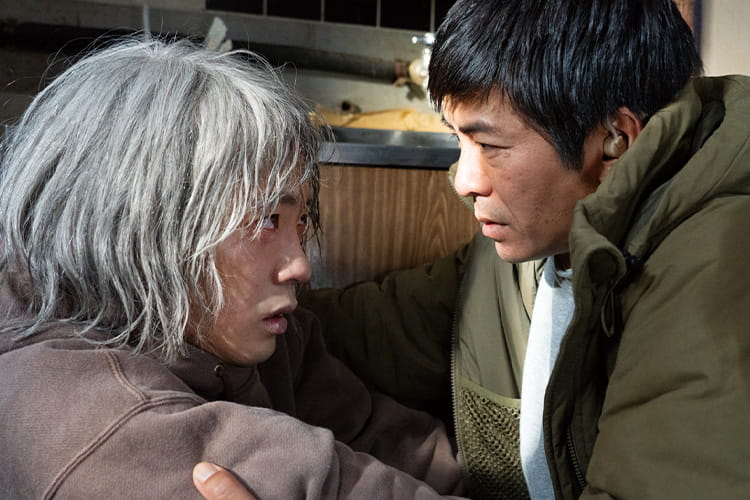Introduction
Yoshiyuki Kishi has, as a director, a quite limited oeuvre. Besides directing two tv-movies, he brought Mariko Koike’s novel Nijyuu Seikatsu (2012)to life on the silver screen – Double Life (2016), and visualized Shuji Terayama’s Aa, Koya (1966) for new audiences to enjoy – Wilderness: Part One (2017), Wilderness: Part Two (2017).
And now, after turning the manga series Toji Tsukishima and Masahito Kagawa’s Zenkamono into a drama for WOWOW, he brings an original story featuring many of the characters of the series to the cinematic screen.
Review
The idealistic Kayo Agawa (Kasumi Arimura), works as a volunteer probation officer. She supervises paroled convicts, like Midori Saito (Shizuka Ishibashi) who is on parole for extortion and injury and Osamu Tamura (-) who is on parole for fraud, and aid their rehabilitation to prevent recidivism.
Six months ago, she started supervising Makoto Kudo (Go Morita) who is on parole for murder and is working in the garage of his parole sponsor Shiro Nakazaki (-). Then one day, the neighbourhood is disturbed by a violent theft that mortally injures a police officer. One month later, the gun is utilized to shoot down municipal welfare worker Yasuko Tanabe. The murder of Asai, a former orphanage worker, leads to a breakthrough. The police finds some of Kudo’s DNA on Asai’s body.
Prior convictions is a narrative that does not only echo the diverse ways in which childhood-abuse and bullying can derail or fracture a subject’s coming into being as well as his ability to inscribe himself in the social fabric, but also reveals, by delving into Agawa’s past, how the trajectory of subjects is determined by the impact of certain events (Narra-note 1).
Despite touching on such heavy themes, Kishi’s narrative is a story of hope, a story that reveals that what helps an ex-convict to reintegrate into society is not an encounter with someone who, as a master, sets out the path for those who failed society, but with someone who succeeds in echoing to him/her that every subject remains at odds with his societal environment. This ‘weakness’ is caused by the structural impossibility for the subject to alienate himself completely into language and, thus, society.
The hope that structures the narrative is closely linked with a question that Kuda poses to Agawa in the beginning of the narrative: can a murderer truly be rehabilitated? Tadaharu Takamatsu (-), the municipal probation officer, offers a glance at the answer by revealing that the success of rehabilitation is function of the nature of the crime. In Takamatsu’s case, his murderous act was impulsive and emotional, a violent response to the bullying he had to endure for four years by the hand of his senior. These impulsive acts, these violent refusals driven by sudden surges of rage, only appear when a vicious imaginary injury, either via an act or a signifier, radically effaces someone’s symbolic existence. In this sense, the burst of violence is an act of protection, to escape the void opened up by the Other.
By making this dynamic explicit, it should be obvious that Kudo is not the perpetrator of the violent theft and the subsequent murders. The theft follows a different logic. Rather than being an act to defend one’s symbolic existence, it is an act seemingly structured by a transgressive need. Yet, what kind of need?
The nature of the need is slowly sketched out by the investigation of the victims by the police. The police officer, so we learn, is eyed by internal affairs due to exploiting his position of representing and enacting the law to intimidate and extort as well as his position of seniority to harass and hit his juniors.
Tanabe appears, if we believe her colleagues’ signifiers, to have been saint-like. Not only did she take on cases that other colleagues were reluctant about, but she also ensured that both the victim of domestic abuse and the abuser was taken care off. Yet, an anonymous letter send to the police HQ, after the murder, implies that Tanabe’s saint-like facade hid a devilish intent.
The flair of immorality or the aspect of neglect that marks the past conduct of the murder-victims echoes that the string of murders is driven by a need to exact revenge and punish all those who played their part in ruining the subject’s possibility to assume a position of neurotic ‘normality’ within the social field. Yet, as Kudo is not the perpetrator, who is the real murderer? And how are he and Kudo connected?
We are also led to question why the police, after finding DNA that links Kudo to Asai, readily assumes that Kudo is the murderer. Do police officer Shinji Takimoto (Hayato Isomura) and his superior not fall into the trap of their own prejudices about criminals, wrongfully erasing the different logic that differentiates Kudo’s past murder and the current string of murders? Takimoto’s dehumanized perspective on murderers, as determined by his past, fuels his passion as officer but also blinds him for the truth that stares him in the face.
Yet, while Prior Convictions explores many relevant themes, it does not succeed to deliver them in a truly touching manner. The reason for this faltering mainly lies in Kishi’s choice to re-use flashbacks and musical accompaniment to give genuine emotional moments their melodramatic flair. While such melodramatic flair might work for some, it actually detracts from the emotions the cast are putting into their characters.
The composition of Prior Convictions is full of subtle and less subtle dynamism – some rare static shots are present as well. Shaky framing technique is used to heighten the believability of his narrative as well as to echo some of the emotionality that marks the characters within the frame. Yet, as the shakiness lacks a rhythm – a rhythm that follows the flow of the character’s emotions, the trembling frame is not fully able to strengthen the trembling subjectivity of the characters.
That the emotional surges can still be felt by the spectator is thus not due to this compositional decoration, but due to the cast. It is, in fact, only because the cast delivers natural and layered performances that emotionality succeeds in touching the spectator.
Prior Convictions offers a very relevant exploration of the fact that the criminal act is, in many cases, born from an antagonistic relation between the subject and the Other – the criminal is, in some way or another, also a victim. Yet, Kishi could have made his narrative more emotionally powerful by making it shorter and removing the ‘ill-placed’ melodramatic decorations.
Notes
Narra-note 1: The events do not simply disturb the subject, but enables him/her to solidify a certain perspective on certain social matters, hereby giving his tr





yet another great watch… kind of annoys me when I read stuff from people complaining about J-cinema being dead. Actually, many quality films -indie or mainstream- have been released during the past 3 years or so…